calsfoundation@cals.org
Ivory-billed Woodpeckers
aka: Campephilus principalis
Long believed to be extinct, the ivory-billed woodpecker (Campephilus principalis) was apparently rediscovered in the Big Woods of east Arkansas in 2004. More than sixty years after the last confirmed sighting in the United States, a research team announced on April 28, 2005, that at least one male ivory-bill survived in the vast bottomland swamp forest. Published in the journal Science, the findings included multiple sightings of the elusive woodpecker and frame-by-frame analyses of brief video footage. The evidence was gathered during an intensive year-long search in the Cache River and White River National Wildlife Refuges in eastern Arkansas, involving more than fifty experts and field biologists working as part of the Big Woods Conservation Partnership, led by the Cornell Laboratory of Ornithology and the Nature Conservancy. However, the U.S. Fish and Wildlife Service announced the bird’s extinction in 2021; in July 2022, it said that it would await evidence for six more months before making the official declaration, and in October 2023 said it was continuing to review information before declaring it extinct.
Ivory-billed woodpeckers were once found in mature bottomland hardwood forests of the southeast United States and Cuba. Because of their specialized diet of beetle larvae, they required an extensive habitat of mature forests with many recently dead, but still standing, trees. To reach the larvae, the birds stripped the still-tight bark from the trees using their large ivory-colored bills, made of bone covered with keratin. The birds were probably never common, but by the 1930s, nearly all of their habitat had been destroyed.
The ivory-billed woodpecker was at one time the third-largest woodpecker in the world and the largest north of Mexico. At eighteen to twenty inches tall, it had a wingspan of thirty to thirty-one inches and weighed sixteen to twenty ounces. It had a black body with large white patches on the wings. A white stripe extended from below each eye down the sides of the neck and onto the sides of the back. When the wings were folded, a large patch of white was visible on the lower back. The male had bright red on its crest, which curved backward; the female’s black crest curved forward. Because the ivory-billed woodpecker looked similar to the slightly smaller, more common pileated woodpecker (Dryocopus pileatus), identification required knowledge of the field marks of both species.
Ivory-billed woodpeckers did not have the undulating flight characteristic of many woodpeckers. Their flight was strong and direct. When traveling long distances, they typically flew above the trees. Their call was a nasal-sounding “kent,” which sounded like the toot of a tin horn. They were known for the unique double-knock they made when striking a tree with their beaks. Ornithologists believed this was used to announce the bird’s presence or establish territory. Most woodpeckers in the ivory-billed’s genus (Campephilus) make a similar double-knock, but the other species live in Latin America.
Knowledge about ivory-billed woodpeckers is limited because there have been so few in-depth studies of the species. Some ornithologists believe they were nomadic, continually searching for habitat. In the 1930s, Cornell University researcher James T. Tanner estimated that each pair of the birds required a territory of at least six square miles. Ivory-billed woodpeckers excavated trees for nesting cavities and roosts. They began breeding in January, laying an average of three eggs per clutch. Both parents care for the young, which fledge at about five weeks and may depend on their parents for a year or more. Ornithologists speculate that they may live twenty to thirty years.
Under the Endangered Species Act, the U.S. Fish and Wildlife Service was required to establish a recovery team to prepare a comprehensive recovery plan for the ivory-billed woodpecker and to advise agencies, stakeholders, and the public on conservation proposals. Many issues remained for the recovery team to sort out, including the compatibility of traditional uses such as hunting and fishing in the region’s wildlife refuges, public accessibility for bird watching, and forest management to enhance the chances of the ivory-billed woodpecker’s survival. The director of the Cornell lab, Dr. John W. Fitzpatrick, noted that the tangible evidence of the ivory-billed woodpecker’s existence “ought to be sufficient to compel a long-overdue national effort to locate any remaining individuals and populations, and simultaneously to launch conservation and recovery planning that prepares us for potential new discoveries.”
In September 2021, the U.S. Fish and Wildlife Service (FWS) announced that it was planning to declare that the ivory-billed woodpecker, along with twenty-two other animals, had gone extinct. However, a paper, not yet peer reviewed, published on a pre-print site for biology in April 2022 offered potential video evidence for the survival of the species in Louisiana, and so the FWS stated, in July 2022, that it would be delaying a public declaration of the extinction of the woodpecker for six months. The following month, Bobby Harrison, an Alabama resident, made public video he shot on October 17, 2020, that ostensibly shows an ivory-billed woodpecker in flight. In October 2023, the FWS stated that the extinction declaration would be further delayed as the agency continued to review information.
For additional information:
Bowden, Bill. “Ivory-Bill Woodpecker Lives, Says Alabaman.” Arkansas Democrat-Gazette, August 3, 2022, pp. 1A, 7A. Online at https://www.arkansasonline.com/news/2022/aug/03/video-presented-as-evidence-ivory-billed/ (accessed August 3, 2022).
———. “Ivory-Billed Woodpecker Wins Time.” Arkansas Democrat-Gazette, July 7, 2022, pp. 1B, 2B. Online at https://www.arkansasonline.com/news/2022/jul/07/birders-get-more-time-to-prove-ivory-billed/ (accessed July 7, 2022).
———. “Woodpecker Video Evidences Species’ Survival.” Arkansas Democrat-Gazette, August 12, 2022, pp. 1B, 6B. https://www.arkansasonline.com/news/2022/aug/12/national-aviary-says-new-video-appears-to-show/ (accessed August 12, 2022).
Bruyninckx, Joeri. Listening in the Field: Recording and the Science of Birdsong. Cambridge, MA: MIT Press, 2018.
Collins, Michael D. “Comments on ‘Echo of Extinction: The Ivory-Billed Woodpecker’s Tragic Legacy and Its Impact on Scientific Integrity.'” BioScience, January 31, 2025. https://doi.org/10.1093/biosci/biae141 (accessed February 3, 2025).
Dufalla, Lucas. “Hope’s on Wing Again in Brinkley.” Arkansas Democrat-Gazette, November 28, 2024, pp. 1A, 3A. Online at https://www.arkansasonline.com/news/2024/nov/27/20-years-later-brinkley-reflects-on-ivory-bill/ (accessed November 28, 2024).
Einhorn, Catrin. “A Vanished Bird Might Live On, or Not. The Video Is Grainy.” New York Times, May 18, 2023. https://www.nytimes.com/2023/05/18/climate/ivory-billed-woodpecker.html (accessed May 18, 2023).
Fitzpatrick, John W., et al. “Ivory-billed Woodpecker (Campephilus principalis) Persists in Continental North America.” Science 308 (June 3, 2005): 1460–1462.
Gallagher, Tim. The Grail Bird: Hot on the Trail of the Ivory-billed Woodpecker. New York: Houghton Mifflin, 2005.
Gandy, Matthew. “An Arkansas Parable for the Anthropocene.” Annals of the American Association of Geographers 112.2 (2022): 368–386. Online at https://doi.org/10.1080/24694452.2021.1935692 (accessed March 16, 2023).
Hill, Geoffrey E. Ivorybill Hunters: The Search for Proof in a Flooded Wilderness. New York: Oxford University Press, 2007.
“The Ivory-Billed Woodpecker and More Than 20 Other Species Have Gone Extinct.” National Public Radio, September 29, 2021. https://www.npr.org/2021/09/29/1041393172/u-s-says-ivory-billed-woodpecker-and-more-than-20-other-species-have-gone-extinc (accessed September 29, 2021).
Jackson, J. A. “Ivory-billed Woodpecker.” The Birds of North America. Ithaca, NY: Cornell Laboratory of Ornithology, 2002.
Latta, Steven C., Mark A Michaels, Don Scheiffer, Thomas C. Michot, Peggy L. Shrum, Patricia Johnson, Jay Tischendorf, Michael Weeks, John Trochet, and Bob Ford. “Multiple Lines of Evidence Indicate Survival of the Ivory-Billed Woodpecker in Louisiana.” bioRxiv, April 8, 2022. https://www.biorxiv.org/content/10.1101/2022.04.06.487399v1.supplementary-material (accessed July 7, 2022).
Michalak, Pawel. “Echo of Extinction: The Ivory-Billed Woodpecker’s Tragic Legacy and Its Impact on Scientific Integrity.” BioScience 74 (November 2024): 740–746. Online at https://doi.org/10.1093/biosci/biae072 (accessed February 3, 2025).
Ramirez, Rachel. “Is the Ivory-Billed Woodpecker Extinct?” CNN, October 29, 2022. https://www.cnn.com/interactive/2022/us/ivory-billed-woodpecker-extinct-courtman-climate-ctpr/ (accessed October 31, 2022).
“Rediscovering the Ivory-billed Woodpecker.” Cornell Lab of Ornithology. http://www.birds.cornell.edu/ivory/ (accessed September 29, 2021).
Troy, Jeff R., and Clark D. Jones. “The Ongoing Narrative of Ivory-Billed Woodpecker Rediscovery and Support for Declaring the Species Extinct.” IBIS: The International Journal of Avian Science 165 (January 2023): 340–351. Online at https://doi.org/10.1111/ibi.13144 (accessed December 12, 2022).
White, Mel. “The Ghost Bird.” National Geographic, December 2006, 142–157.
Jane Jones-Schulz
Arkansas Natural Heritage Commission
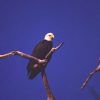
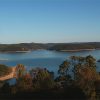
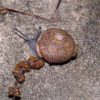


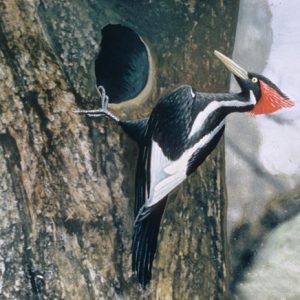

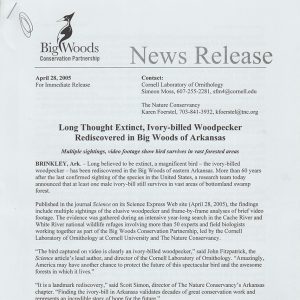





Comments
No comments on this entry yet.